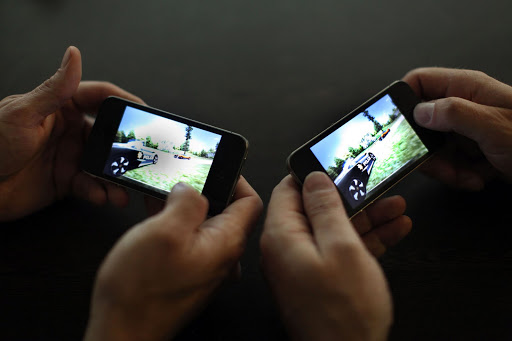Who actually won the console wars? That depends on whom you ask.
Forbes writer Erik Kain claims that Sony won long ago. To back this up, he cites Sony’s robust console sales throughout the years and proclaims that the company “left Microsoft behind from the start.”
Meanwhile, his Forbes colleague Kevin Murnane claims Microsoft has won. He cites Microsoft’s extensive investment in cloud-based technology and believes that if cloud is the future of gaming, Microsoft is the future of cloud.
In truth, both of these perspectives are wrong. The real winner of the console wars is your smartphone and here’s why!
Easy access

For gamers, the biggest convenience of the smartphone is obvious. It offers a surprising amount of gaming power packed into a device that you already own.
Anyone with a smartphone and an internet connection has access to thousands of games at any time. And they don’t need to carry these games around as cartridges or discs — everything is conveniently contained within their phone.
Easy access means more gamers. That’s why 2.2 billion people play mobile games around the world. On top of that, mobile games accounted for half of the gaming market in 2018.
Low cost

One factor that goes hand-in-hand with easy access is low cost. Simply put, anyone with a smartphone can start gaming right away without plunking down a few hundred dollars for a new system.
Many free games are available, which allows people on a budget to still get their game on. Other games generally cost between $5-$10, making them far cheaper than a standard $60 game for your Xbox or PlayStation.
Thanks to things like the “freemium” model (free games that charge for premium features), these games generate major revenue for developers. That’s why mobile gaming revenue is projected to hit $76.7 billion by the end of 2020. In fact, the number may be even higher due to COVID-19 driving unexpected game sales.
Gaming on the go

One of the more surprising developments in game history concerns handheld gaming. After the 1990s, Nintendo was the only traditional game company focusing on portable consoles. They have enjoyed major success with the Nintendo DS, 3DS, and now the Switch Lite.
Despite this, cost and access remain a big factor for mobile gaming. The Switch Lite is the only viable modern portable console, and it will still set you back $200. Throw in some games, and your costs quickly skyrocket.
With smartphones, players have a portable game console on them at all times for no additional cost. They can quickly play a game wherever they are and whenever they have some downtime.
Perhaps that’s why gaming accounts for a staggering 43% of smartphone use. If you see someone on their phone, there is a very good chance they are in the middle of playing something!
Casual kings

So, what kind of games are popular among mobile gamers? As you might expect, the most popular games are casual in nature. In fact, 58.86% of mobile players consider themselves “casual gamers.”
This is the primary cause of the rift between console players and mobile players. Console players are generally more competitive and more serious about their hobby, and some of them don’t consider mobile-only players as “real” gamers.
In terms of economic and cultural importance, though, you can’t dismiss mobile gaming.
China takes the lead

Video games, like movies, are largely influenced by the Chinese market. And mobile games are explosively popular in China
Mobile gaming revenue has steadily grown in China in recent years. Now, forecasters predict that mobile revenue for the country will reach $25.49 billion by 2023.
Long story short? Asia is the largest global gaming marketplace, and China accounts for the majority of that market. As long as mobile gaming remains popular in China, smartphones will continue to beat consoles year after year.
The retro factor

Not all console gamers are opposed to smartphone gaming. In fact, retro gamers have discovered the true potential that smartphones have for their hobby.
Once you jailbreak a smartphone, it is easy to load it with emulators and ROM files. And while this is a legal minefield, it hasn’t kept nostalgic gamers from bringing a library of their favorite classic games wherever they go.
Again, it all comes back to access and price. Those same players could try to modify an old Nintendo 3DS for the same purpose. But why spend extra time and money if you already have an old phone that will do the trick.
A vicious cycle

Not everything about smartphone gaming is so rosy. For example, critics often point out how many games are seemingly designed to nickel-and-dime players for various add-ons and gameplay options.
This led to a trend of children racking up major charges on their parent’s credit cards. And it is often difficult for those parents to get their money back after these predatory apps have done their job.
On top of that, the profits generated from these microtransactions have influenced console gaming as well. We likely wouldn’t have countless microtransactions from companies such as EA if mobile games weren’t making such a killing from this model.
If you can’t beat ’em, join ’em

What is the biggest sign that smartphones won the console wars? It’s the fact that traditional gaming companies are now rushing into the mobile space.
Microsoft and Sony are both exploring options that would allow gamers to stream Xbox and Playstation games to their phones and tablets. In this way, they hope to get a piece of the mobile gaming pie while keeping fans focused on consoles.
And Nintendo has led the way in creating innovative smartphone apps. Super Mario Run, Mario Kart Tour, and Pokemon Go all prove that Nintendo can succeed — and profit — outside the world of console gaming.
Like it or not, we’ve seen the future of gaming. And it’s already in your pocket.
Category: Articles


